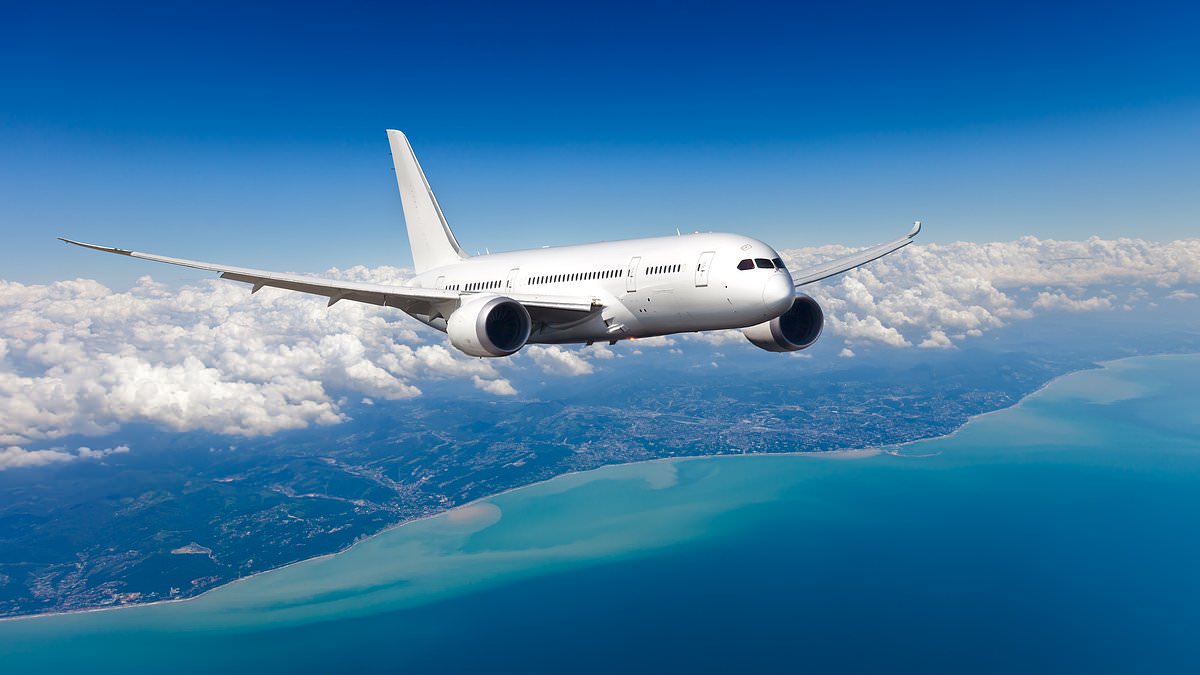A plane carrying nearly 300 holidaymakers came within 20 minutes of disaster after nearly running out of fuel in mid-air.
The Boeing 787-8, flying from Cancun in Mexico, was due to arrive at Manchester Airport during Storm Pia’s 100mph winds in December 2023.
Gearing up to land, the pilot was informed he was behind seven aircraft that were waiting for conditions to ease so they could land safely.
Air traffic controllers could not give him an estimated time for landing, so the 62-year-old commander elected to divert to East Midlands Airport.
But East Midlands said it could not cope with an aircraft of his size, so he was redirected to Birmingham.
Extreme winds forced him to abort the first landing attempt. Circling round to have a second go, he declared a ‘mayday’ because the jet was running dangerously low on fuel.
At that stage, the jet – which was sent on a 28-mile detour despite declaring a fuel emergency – could not fly to another airport.
A safety report issued today by the Air Accidents Investigation Branch (AAIB) said the plane, carrying 291 passengers and ten crew, touched down with just 1,250kg of fuel.
With the plane burning 60.5kg per minute, it would likely have run out of fuel within 20 minutes – barely enough time to land if it had to go around a second time due to high winds.
Under safety rules, it should have landed with 1,911kg fuel.
The TUI passenger jet, flight number TOM173, departed Cancun at 5.50pm local time on December 20, 2023, for an overnight flight to Manchester.
Crew were informed of strong winds in England, but believed they would dissipate at around 6am, with the aircraft due to land at 7.35am.
Nonetheless, they elected to load an additional 984kg of fuel as a precaution, equivalent to around 15 minutes of flying.
They first contacted Manchester Air Traffic Control at 7.18am where they were told to circle above the airport, behind seven planes already waiting. At that point, the jet had 5,500kg of fuel remaining.
The controller told the pilot that it was not possible to provide a landing time since the delay was unknown. The pilot circled their airport several times before seeking to divert.
The windspeed was around 32mph, with gusts of up to 47mph.
At 7.28am the pilot called East Midlands Radar advising that they may need to divert there, but three minutes later they were told ‘we cannot accept your size aircraft’.
At 7.41am – six minutes after their scheduled landing time – the plane’s diversion to Birmingham Airport was accepted but it only had around 4,100kg of fuel left. This is the equivalent of about an hour.
On first contact with radar, the pilot said: ‘We are gonna be on minimum fuel.’
At 8.05am the plane was cleared to land and started to descend but had to abandon the landing 240ft above ground due to wind speeds, which were gusting at 43mph.
During the climb out to 4,000ft, at 8.08am, the crew contacted Birmingham’s radar saying ‘TOM173 MAYDAY MAYDAY MAYDAY, TOM173 MAYDAY FUEL’.
Air traffic controllers send the jet on a route 25 miles south of the airport before placing them behind a second aircraft – more than doubling the distance to 53 miles, costing them a total of 1,450kg of fuel.
The added 28 miles reduced the jet’s fuel reserve by a further 400kg.
The plane eventually touched down in Birmingham at 8.26am with 1,250kg of fuel, equivalent to around 20 minutes of flight time.
The flight was supposed to last eight hours and 45 minutes, but instead lasted nine hours and 36 minutes.
The AAIB report into the incident found that the air traffic controller at Birmingham should have priorotised the flight sooner.
The investigation concluded that the controller was faced with a ‘complex and high workload scenario’ which resulted in the opportunity to prioritise TOM173 while repositioning a Wizz Air plane being missed.
This resulted in TOM173 flying an extended track even though it had declared a fuel emergency, the report stated.
The AAIB report concluded: ‘While allowing for the contingencies required by the regulations, operators seek to minimise the carriage of fuel necessary for the flight, owing to the fuel burn penalty from carrying excess fuel.
‘Nevertheless, the crew identified a threat of high winds and the potential for delays on arrival at Manchester Airport.
‘Incorrectly believing that the winds would dissipate from 0600 hrs, the commander requested some extra fuel, equivalent to about an additional 15 minutes of fuel. Given the aircraft weights, the crew had the option to load significantly more fuel.
‘The consequential reduction in fuel remaining had the effect of reducing the options available to achieve a safe landing, if the aircraft had encountered windshear on the second approach.
‘The serious incident was the result of strong winds generating difficult conditions at the time of the arrival of the flight into the UK.
‘Safety action has been taken to clarify the process for determining and communicating airport capacity for diversions, and for the prioritisation of aircraft that have declared an emergency.’
has approached TUI for a comment.
